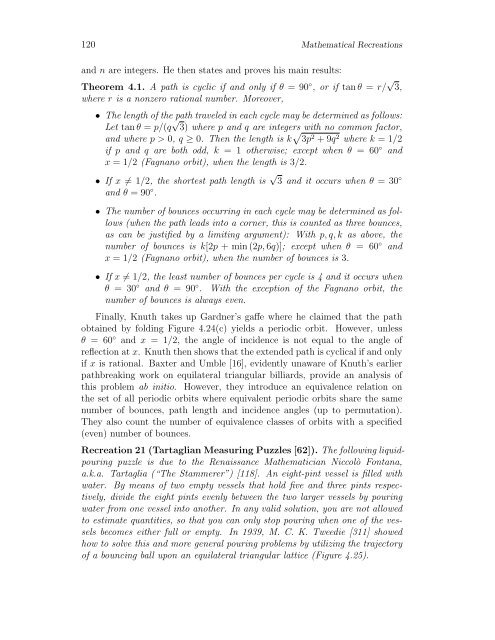MYSTERIES OF THE EQUILATERAL TRIANGLE - HIKARI Ltd
MYSTERIES OF THE EQUILATERAL TRIANGLE - HIKARI Ltd
MYSTERIES OF THE EQUILATERAL TRIANGLE - HIKARI Ltd
You also want an ePaper? Increase the reach of your titles
YUMPU automatically turns print PDFs into web optimized ePapers that Google loves.
120 Mathematical Recreations<br />
and n are integers. He then states and proves his main results:<br />
Theorem 4.1. A path is cyclic if and only if θ = 90 ◦ , or if tanθ = r/ √ 3,<br />
where r is a nonzero rational number. Moreover,<br />
• The length of the path traveled in each cycle may be determined as follows:<br />
Let tanθ = p/(q √ 3) where p and q are integers with no common factor,<br />
and where p > 0, q ≥ 0. Then the length is k � 3p 2 + 9q 2 where k = 1/2<br />
if p and q are both odd, k = 1 otherwise; except when θ = 60 ◦ and<br />
x = 1/2 (Fagnano orbit), when the length is 3/2.<br />
• If x �= 1/2, the shortest path length is √ 3 and it occurs when θ = 30 ◦<br />
and θ = 90 ◦ .<br />
• The number of bounces occurring in each cycle may be determined as follows<br />
(when the path leads into a corner, this is counted as three bounces,<br />
as can be justified by a limiting argument): With p, q, k as above, the<br />
number of bounces is k[2p + min (2p, 6q)]; except when θ = 60 ◦ and<br />
x = 1/2 (Fagnano orbit), when the number of bounces is 3.<br />
• If x �= 1/2, the least number of bounces per cycle is 4 and it occurs when<br />
θ = 30 ◦ and θ = 90 ◦ . With the exception of the Fagnano orbit, the<br />
number of bounces is always even.<br />
Finally, Knuth takes up Gardner’s gaffe where he claimed that the path<br />
obtained by folding Figure 4.24(c) yields a periodic orbit. However, unless<br />
θ = 60 ◦ and x = 1/2, the angle of incidence is not equal to the angle of<br />
reflection at x. Knuth then shows that the extended path is cyclical if and only<br />
if x is rational. Baxter and Umble [16], evidently unaware of Knuth’s earlier<br />
pathbreaking work on equilateral triangular billiards, provide an analysis of<br />
this problem ab initio. However, they introduce an equivalence relation on<br />
the set of all periodic orbits where equivalent periodic orbits share the same<br />
number of bounces, path length and incidence angles (up to permutation).<br />
They also count the number of equivalence classes of orbits with a specified<br />
(even) number of bounces.<br />
Recreation 21 (Tartaglian Measuring Puzzles [62]). The following liquidpouring<br />
puzzle is due to the Renaissance Mathematician Niccolò Fontana,<br />
a.k.a. Tartaglia (“The Stammerer”) [118]. An eight-pint vessel is filled with<br />
water. By means of two empty vessels that hold five and three pints respectively,<br />
divide the eight pints evenly between the two larger vessels by pouring<br />
water from one vessel into another. In any valid solution, you are not allowed<br />
to estimate quantities, so that you can only stop pouring when one of the vessels<br />
becomes either full or empty. In 1939, M. C. K. Tweedie [311] showed<br />
how to solve this and more general pouring problems by utilizing the trajectory<br />
of a bouncing ball upon an equilateral triangular lattice (Figure 4.25).

















